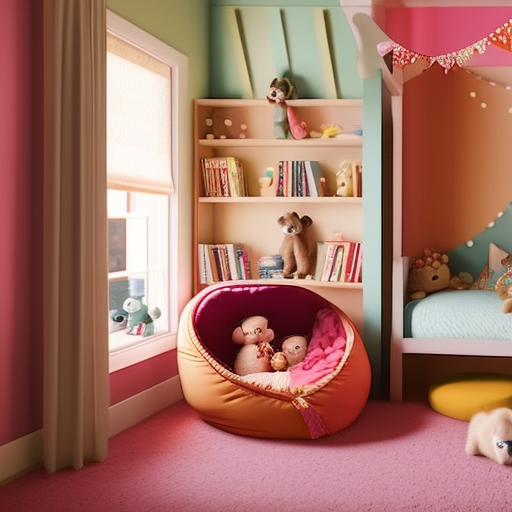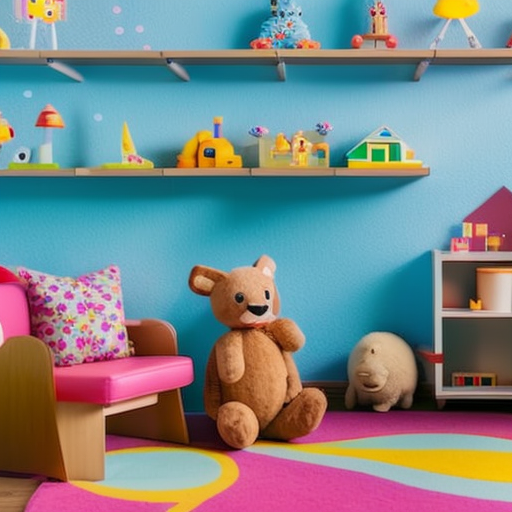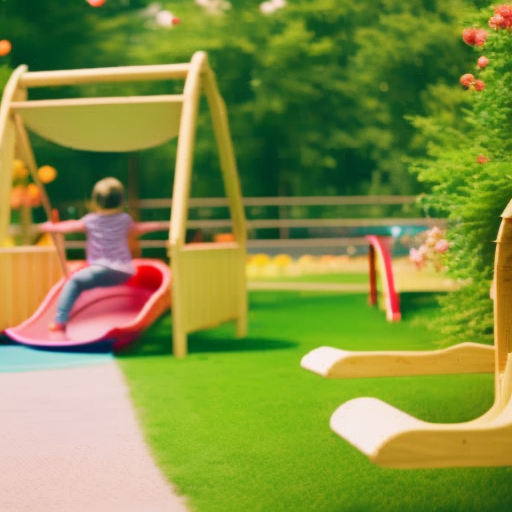"Cherishing Little Steps - A Haven for Baby and Family Journeys"
Creating a Child-Friendly Home Environment
Do you want to create a home where your little ones can play and explore freely?
Creating a child-friendly home environment is essential to ensure their safety and well-being. By childproofing the living area, securing furniture and appliances, and choosing child-friendly flooring options, you can minimize potential hazards.
Organizing and storing toys and belongings, designing a safe and functional kitchen space, and setting up a play area or designated playroom will make your home a haven for your children.
Don’t forget about outdoor safety and supervision, as well as maintaining a clean and hygienic home environment. With these simple steps, you can create a space where your children can thrive and grow, while giving you peace of mind.
Key Takeaways
- Assess the living area for potential hazards and take necessary safety measures
- Install baby gates, electrical outlet covers, corner protectors, and furniture straps to ensure childproofing
- Secure cabinets, drawers, and appliances with safety locks and guards
- Create child-friendly spaces by incorporating storage solutions, comfortable bedding, educational toys, and sensory corners
Childproofing the Living Area
-
To create a child-friendly living area, your first step is to assess the space for potential hazards and make any necessary adjustments. Start by installing baby gates to prevent your little one from accessing areas that may be unsafe, such as staircases or rooms with fragile objects. These gates will provide a physical barrier, giving you peace of mind while your child explores the surroundings.
-
Another crucial aspect of childproofing is covering electrical outlets. Babies are naturally curious and may try to insert objects into outlets, which can lead to dangerous situations. Use electrical outlet covers to block access to these potentially harmful sources of electricity. It’s a simple yet effective way to protect your child from accidents.
-
As you evaluate the living area, keep an eye out for other potential hazards such as sharp edges on furniture or loose cords that could pose a strangulation risk. Address these issues by using corner protectors and securing cords out of reach.
-
Creating a childproof environment isn’t only about physical modifications but also about being vigilant and proactive. Regularly check for any new hazards that may arise as your child grows and gains new abilities. By staying attentive and making necessary adjustments, you can ensure that your living area remains a safe and enjoyable space for your little one to explore.
Securing Furniture and Appliances
To further childproof your living area, secure furniture and appliances to prevent accidents. Children are naturally curious and can easily pull or climb on furniture, causing it to topple over. Anchoring bookshelves and other tall furniture is crucial to ensure their stability. Use furniture straps or wall brackets to secure bookshelves, cabinets, and dressers to the wall. This will prevent them from tipping over and potentially injuring your child.
Another important item to secure is the television. Large, flat-screen TVs can be a tipping hazard if not properly secured. Mount the TV to the wall or use a TV strap to secure it to a stable piece of furniture. This will prevent it from falling and causing harm to your child.
To help you visualize the importance of securing furniture and appliances, take a look at the table below:
| Potential Hazards | Secure Solutions |
|---|---|
| Tipping furniture | Anchoring bookshelves and cabinets to the wall using furniture straps or wall brackets. |
| Falling TVs | Mounting the TV to the wall or using a TV strap to secure it to a stable piece of furniture. |
Choosing Child-Friendly Flooring Options
When selecting flooring options for a child-friendly home, prioritize materials that provide comfort, durability, and safety for your little ones. Here are four key factors to consider:
-
Non-slip flooring: Kids are constantly on the move, and slips and falls are bound to happen. Opt for flooring that offers good traction to prevent accidents. Look for materials like cork, rubber, or textured vinyl that provide a slip-resistant surface.
-
Easy to clean options: Let’s face it, kids can be messy. From spilled drinks to muddy footprints, your floors will face their fair share of spills and stains. Choose flooring that’s easy to clean and maintain. Materials like laminate or tile are great choices as they can be quickly wiped down or mopped, making cleanup a breeze.
-
Durable materials: Children can be rough on floors, especially during playtime. Invest in flooring that can withstand the wear and tear of little feet and toys. Hardwood, bamboo, or luxury vinyl are excellent options that offer both durability and style.
-
Soft and comfortable surfaces: Kids love to play on the floor, so it’s important to provide a comfortable surface for them. Consider carpeting in play areas or bedrooms to create a cozy and cushioned environment. Alternatively, area rugs can be used to add softness to hard floors.
Organizing and Storing Toys and Belongings

Keep your child’s toys and belongings organized and easily accessible to promote a clutter-free and functional space in your child-friendly home. Maintaining an organized environment not only helps to keep your child’s toys in good condition but also encourages independent play and creativity.
One effective strategy for managing toys is through toy rotation. By dividing toys into sets and periodically rotating them, you can keep your child engaged and interested while preventing overwhelming clutter. This also helps to extend the lifespan of toys, as they won’t be constantly in use.
Additionally, organizing art supplies is essential for fostering your child’s creativity. Designate a specific area or storage unit for art materials such as paints, markers, and paper. Use clear containers or labeled bins to make it easy for your child to identify and access the materials they need. Consider using a low shelf or table where your child can easily reach their art supplies, encouraging them to engage in artistic endeavors independently.
Remember that involving your child in the organizing process can be a fun and educational experience. Teach them the importance of tidiness and responsibility by encouraging them to put their toys away after playtime.
Creating a Safe and Functional Kitchen Space
For a child-friendly home environment, it’s important to ensure that your kitchen is a safe and functional space. Here are four essential tips to help you create a child-friendly kitchen:
-
Childproof your kitchen appliances: Install safety locks on cabinets and drawers where hazardous items such as cleaning supplies and sharp utensils are stored. Keep small appliances, like blenders and toasters, out of reach or unplugged when not in use. This will prevent curious little hands from accidentally turning them on.
-
Invest in child-friendly kitchen utensils: Look for utensils specifically designed for children, with rounded edges and easy-to-grip handles. This will make it easier for them to help out in the kitchen and develop their culinary skills in a safe manner.
-
Secure loose cords and wires: Keep electrical cords and wires tucked away and out of reach. Use cord organizers or tie them up to prevent tripping hazards or accidental pulls.
-
Create designated kid-friendly zones: Set up a designated area in the kitchen where children can safely play or engage in age-appropriate activities. This could be a small table and chairs or a corner with educational toys and books.
Designing a Child-Friendly Bedroom

Design a cozy and functional sleep space for your child with these essential tips for creating a child-friendly bedroom. A child’s bedroom should be a place of comfort and security, where they can rest and recharge. By incorporating child-friendly bedroom decor and creating a cozy sleep space, you can ensure that your child gets the rest they need.
To start, choose a theme or color scheme that your child will love. This could be their favorite cartoon character, a sports team, or a nature theme. Use this theme as a guide when selecting bedding, curtains, and wall decor.
Next, think about storage solutions. Children have a lot of toys and belongings, so it’s important to have a place for everything. Consider using bins, shelves, and a toy chest to keep things organized and easily accessible.
Finally, focus on creating a comfortable sleep environment. Invest in a quality mattress and choose bedding that is soft and cozy. Consider blackout curtains to block out light and create a peaceful atmosphere. And don’t forget to add a nightlight for a comforting glow.
By following these tips and creating a child-friendly bedroom, you can provide your child with a safe and comfortable space to rest and relax. Sweet dreams!
| Tips for Creating a Child-Friendly Bedroom |
|---|
| Choose a theme or color scheme that your child loves |
| Provide ample storage solutions for toys and belongings |
| Invest in a quality mattress and soft bedding |
| Consider blackout curtains and a nightlight for a cozy sleep environment |
Setting up a Play Area or Designated Playroom

To ensure a well-rounded child-friendly home environment, it’s important to set up a designated play area or playroom where your child can engage in imaginative play and active recreation. Here are four essential tips to help you create the perfect play space for your little one:
-
Interactive learning: Incorporate educational toys and activities that encourage interactive learning. Choose toys that promote problem-solving, creativity, and cognitive development. This won’t only keep your child entertained but also stimulate their curiosity and learning abilities.
-
Creating a sensory corner: Include a sensory corner in the play area to engage your child’s senses. This can be achieved by incorporating items such as textured toys, musical instruments, and sensory boards. The sensory corner will provide a stimulating and calming space for your child to explore and develop their sensory skills.
-
Organized storage: Keep the play area tidy and organized by investing in storage solutions such as bins, shelves, and labeled containers. This will make it easier for your child to find and put away their toys, promoting independence and teaching them the importance of cleanliness and organization.
-
Safety first: Ensure the play area is safe for your child by childproofing the space. Install safety gates, cover electrical outlets, and secure heavy furniture to prevent accidents. Regularly inspect toys for any signs of wear or damage and remove any potentially hazardous items.
Ensuring Outdoor Safety and Supervision

Make sure you regularly supervise your child outdoors to ensure their safety.
When it comes to outdoor play, it’s important to create a child-friendly environment that promotes both fun and safety. One way to do this is by carefully selecting and maintaining outdoor play equipment. Ensure that the equipment is age-appropriate and in good condition, with no sharp edges or loose parts. Regularly inspect and clean the equipment to prevent any accidents or injuries.
Another crucial aspect of ensuring outdoor safety is by creating a safe backyard environment. Remove any potential hazards such as sharp objects, poisonous plants, or stagnant water. Install a fence around your backyard to prevent your child from wandering off and ensure that the gate is secure. Keep an eye out for any potential dangers, such as holes in the ground or slippery surfaces, and address them immediately.
In addition to supervision and a safe environment, it’s important to educate your child about outdoor safety. Teach them about the importance of wearing protective gear such as helmets and knee pads when riding bikes or using other wheeled toys. Teach them about the dangers of strangers and the importance of staying within the boundaries of your property.
Maintaining a Clean and Hygienic Home Environment
Regular cleaning and sanitizing of your child’s living spaces is essential for maintaining a hygienic home environment. Here are four tips to help you keep your home clean and safe for your little one:
-
Establish a cleaning schedule: Set aside specific times each day or week dedicated to cleaning. This will help you stay organized and ensure that all areas of your home are regularly cleaned and maintained.
-
Use child-friendly cleaning products: When selecting cleaning products, opt for those that are non-toxic and safe for children. Look for labels that indicate they’re specifically designed for use around kids. This way, you can clean with peace of mind knowing that your child won’t be exposed to harmful chemicals.
-
Focus on high-touch areas: Pay extra attention to surfaces that are frequently touched by your child, such as doorknobs, light switches, and toys. Regularly disinfecting these areas will help prevent the spread of germs and keep your child healthy.
-
Involve your child in cleaning: Teach your child the importance of cleanliness by involving them in age-appropriate cleaning tasks. This not only helps instill good habits but also makes cleaning a fun and interactive activity for the whole family.
Frequently Asked Questions
How Can I Encourage My Child to Help Maintain a Clean and Hygienic Home Environment?
You can encourage your child to help keep the house clean by teaching them cleaning habits and fostering their independence. Show them how to tidy up and make it fun, so they’ll be motivated to lend a hand.
What Are Some Tips for Selecting Child-Friendly Flooring Options That Are Also Easy to Clean?
When it comes to child-friendly flooring options that are also easy to clean, consider materials like vinyl or laminate. They are durable, low-maintenance, and can withstand spills and messes that come with having kids around.
How Can I Ensure Outdoor Safety and Supervision Without Restricting My Child’s Freedom to Explore?
To ensure outdoor safety and still let your child explore freely, create a designated play area with secure boundaries. Install childproof gates, use non-toxic outdoor materials, and provide constant supervision to ensure their safety while they enjoy outdoor play.
Are There Any Specific Guidelines for Securing Furniture and Appliances to Prevent Accidents?
To prevent accidents and keep your child safe, it’s important to secure furniture and childproof appliances. Make sure to anchor heavy furniture to the wall and use safety straps for appliances.
What Are Some Creative Ways to Organize and Store Toys and Belongings to Maximize Space in a Child-Friendly Home?
Looking for creative ways to organize and store toys and belongings in your child-friendly home? Maximize space with clever storage solutions like under-bed bins, hanging organizers, and multi-functional furniture. Get organized and make the most of your space!
Conclusion
In conclusion, creating a child-friendly home environment is essential for the safety and well-being of your little ones. Remember the saying, ‘An ounce of prevention is worth a pound of cure.’
By childproofing your living area, securing furniture and appliances, choosing the right flooring, organizing toys, and setting up designated play areas, you can ensure a safe and enjoyable space for your children to grow and thrive.
With proper supervision and maintenance, your home can be a haven for your little adventurers.


